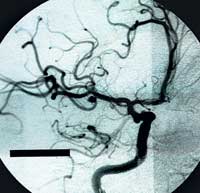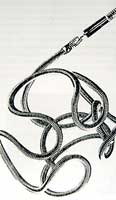Shriyani Abeykoon is going about her routine household chores. A mother of two daughters, there is no outward sign that middle-aged Shriyani has suffered and recovered from a double jeopardy dealt to her in a span of just 11/2 years.
Two brain aneurysms and one dealt with as recently as July without opening up the skull for major brain surgery but through radiological intervention.
 |
| Shriyani |
“For the first one which happened last year in January, I underwent brain surgery,” says Shriyani ever thankful to the doctors headed by Consultant Neurosurgeon Dr. Sunil Perera of the National Hospital who saved her life then. When the first aneurysm burst she had collapsed at home and been rushed to hospital with bleeding in the brain. “I had long hair,” smiles Shriyani, “but it was chopped off for the brain operation. There is still a soft area in the skull where there is no bone.
The second aneurysm, detected during tests after the first ruptured, was a different story. No shaving of the head, no sawing off a part of the skull, no chance of a scalpel touching the brain and leaving her paralysed or with a facial disfigurement due to the nerves being affected.
Whereas, earlier she spent many days in the Neuro-Intensive Care Unit of the National Hospital, this time round she walked out in a few days.
Shriyani is among eight people who have undergone a trailblazing procedure called “embolization” in the treatment of brain aneurysms, first done in the state health sector in Sri Lanka at the National Hospital in January 2004, with the local medical team being supported by two Indian doctors.
Explaining what an aneurysm is before getting into the details of how it is repaired with the Digital Subtraction Angiography (DSA) machine, Dr. Nihal Wijewardena, Consultant Interventional Radiologist says the branching point of a blood vessel (also known as bifurcation or forking) is generally weak and there could be a tendency for this point to balloon out and rupture causing haemorrhage in the brain.
“Under this new technique or ‘interventional radiological procedure’ done under general anaesthesia, a catheter is passed through a blood vessel, after making a small incision in the groin,” says Dr. Wijewardena who attended on Shriyani. “From the groin -- the safest part of entry, found easily and superficially, with a bone underneath -- the catheter is navigated through the main femoral vessel, up to the aorta and on to the blood vessel in the brain with the aneurysm and kept at the neck of the lesion (aneurysm). Thereafter, a procedure of blocking or embolization is carried out.”
 |
| An aneurysm in the brain |
Embolization, The Sunday Times learns, is the packing of the balloon (aneurysm sac) with the insertion of a type of glue to solidify the aneurysm sac, or coils or balloons. Once embolized, the aneurysm sack will become smaller and smaller and heal, preventing a bleed.
Quoting figures at the National Hospital, Dr. Lakmalie Paranahewa, another member of the team, says that 52 patients with aneurysms had been diagnosed between July 5, 2007 and July 5, 2008 at the Digital Subtraction Angiography Unit of the NHSL.
The global mortality rate due to aneurysms is very high, she says, adding that 80% of sub-arachnoid haemorrhage in non-traumatic cases is due to aneurysms. “Of this number 50-60% die,” she adds.
Aneurysms need immediate attention, emphasizes Dr. Paranahewa, adding that if there has been one bleed into the brain, a re-bleed has to be pre-empted and the critical period of a re-bleed is 10 days. If there is a re-bleed, the patient’s death or paralysis is imminent. “That is why embolization needs to be done quickly within the first 10 days.”
But looking at it directly, embolization seems to be an expensive procedure, with coils costing about Rs. 100,000 and each catheter about Rs. 85,000. “For some patients we may need only a few coils, two to three, but depending on the size of the aneurysm, it may be as many as 10 or more,” says Dr. Wijewardena.
 |
 |
| Coils |
In some cases once the coiling is done if it juts out at the bottom of the aneurysm because of the wide neck of the aneurysm, then we have to pull back the original coil and resend it under the balloon-assisted coiling method, adds Dr. Paranahewa. This costs about Rs. 250,000.
If the neck of the aneurysm is so wide that the jutting is inevitable, then stents are used in stent-assisted coiling, she explains.
But when taking the cost to the state of keeping a patient in the ICU for a long time after brain surgery, embolization of an aneurysm is cost-effective.
“As the patient gets back home a few days after embolization, the ICU beds become free for other patients while also relieving the work of nurses and doctors so that they can treat others,” says Dr. Wijewardena.
Donors need
of the hour
Are there any kind donors or a system like the President’s Fund to help needy patients who urgently require embolization to save their lives?
Help save a life, is the plea of the medical team handling this procedure.
Currently, though embolization at the National Hospital is done free of charge, the patient has to buy the catheters and coiling etc which cost dearly. Sometimes by the time the relatives find the money for the embolization, the patient may have died because of the need to carry out the procedure quickly, The Sunday Times understands.
|




